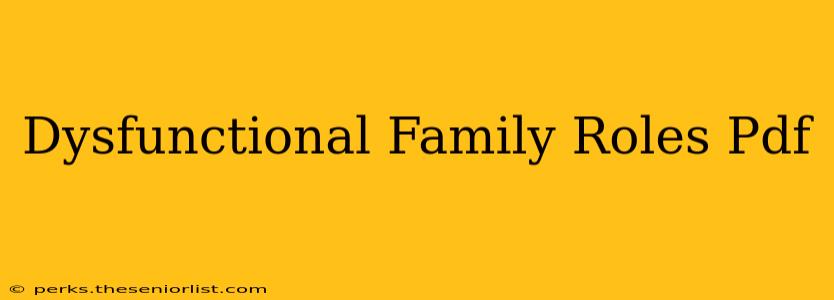Dysfunctional families, unfortunately, are a common occurrence. While every family experiences conflict and challenges, a dysfunctional family is characterized by persistent, unhealthy patterns of interaction that negatively impact the emotional and psychological well-being of its members. Understanding the roles individuals often assume within these systems is crucial to recognizing and addressing the issues at hand. This overview explores common dysfunctional family roles, offering insight without providing a substitute for professional guidance. It is important to remember that this is not an exhaustive list and individual experiences can be highly complex.
Common Dysfunctional Family Roles
Individuals within dysfunctional families often adopt specific roles to cope with the family's dysfunction. These roles, while seemingly providing a sense of order, often perpetuate the cycle of unhealthy behaviors. Some of the most prevalent roles include:
1. The Hero
The hero strives for perfection, often achieving high levels of academic or professional success. They act as the family's "good child," masking underlying issues and attempting to compensate for the dysfunction. While seemingly positive, this role can lead to significant stress, burnout, and feelings of inadequacy if the individual is unable to meet the unrealistic expectations they've placed upon themselves.
2. The Scapegoat
The scapegoat is often blamed for the family's problems, even when they are not the direct cause. This role allows other family members to avoid confronting their own issues. Scapegoats may exhibit acting-out behaviors as a way to express their pain and frustration, often leading to conflict and further reinforcing their negative label within the family dynamic.
3. The Lost Child
The lost child is often quiet, withdrawn, and emotionally distant. They avoid conflict and attention, often escaping into solitary activities or fantasy worlds. This withdrawal can stem from a desire to avoid the pain and chaos of the dysfunctional family system. While appearing independent, the lost child may experience significant loneliness and difficulty forming healthy relationships.
4. The Mascot
The mascot uses humor and silliness to deflect attention from the family's problems. They often act as a buffer, relieving tension through laughter and distraction. While appearing carefree, this role masks deep-seated emotional pain and a fear of vulnerability. Underlying this behavior may be a desperate attempt to alleviate the family's emotional burden.
5. The Enabler
The enabler, often a parent, unconsciously supports the dysfunctional behaviors of others in the family. They might protect addicted members or ignore abusive behavior. Enablers often believe they are helping, but their actions actually perpetuate the unhealthy patterns. This often stems from their own emotional needs and fears.
Seeking Help and Support
Recognizing dysfunctional family roles is a crucial first step toward healing. However, understanding these roles is not a substitute for professional help. If you are struggling with a dysfunctional family system, seeking help from a therapist or counselor is strongly recommended. Therapy can provide a safe space to process emotions, develop coping mechanisms, and break free from unhealthy patterns. Support groups can also be invaluable resources for connecting with others who share similar experiences.
Disclaimer: This information is intended for educational purposes only and should not be considered medical advice. If you are experiencing emotional distress or believe you are in a dysfunctional family system, please seek professional help.
